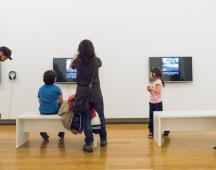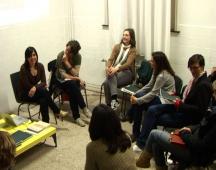Conferencia en Capital...
- A trama rurubana
PARTICIPATION ON THE WORKSHOP CAPITAL AND TERRITORY.
THE CONSTRUCTION OF A DREAM? ON CAPITAL AND TERRITORY II (ON THE NATURE OF ECONOMY... AND OF CULTURE)
Friday_16th October 2009
Coordination: Mar Villaespesa
Sede del Rectorado de la Universidad Internacional de Andalucía [Monasterio Santa María de las Cuevas]
PROGRAMME OCTOBER 2009
Wednesday_14th October 2009 ·
5:00 p.m. Presentation of the work carried out by three research groups at the workshop entitled Capital and Territory. The Construction of a Dream?
Thursday_15th October 2009
· 10:00 a.m. - 2:00 p.m. Presentation of the papers that arose out of the Capital and Territory. The Construction of a Dream? workshop
· 6:30 p.m. Projection of Dennis O’Rourke’s film: Cannibal Tours, 1988, 72 min
· 8:00 p.m. The City in Disguise: The Impact of Tourism on Santa Fe, New Mexico , by Lucy R. Lippard Presented by Beatriz Herráez
Friday_16th October 2009
· 10:00 a.m. - 2:00 p.m. Presentation of the papers that arose out of the Capital and Territory. The Construction of a Dream? workshop
· 6:30 p.m. Álvarez, The Crossing and Other Places, by Carme Nogueira
· 8:00 p.m. Metropolitan Narratives. Forms of Learning in the Geography of the Common, by Sitesize
On Capital and Territory continues during this course its programme of activities, bringing to a close the series that began in 2007. The project was conceived as a result of the interest shown by UNIA artandthinking in analysing how the production of space is a key aspect in capitalist economy and in approaching it from inter-disciplinary reflection –anthropology, urban geography, psychoanalysis, philosophy and ecologic economy are the different fields of research of the theoreticians taking part in the course– and from the exchange of artistic and activist experiences. This convergence has allowed for complex responses to different questions: How does economic logic affect the configuration of the urban environment? What role has urban development played in the dynamics of the accumulation of capital? How does the unconscious psychic structure of late capitalism affect the configuration of residential and commercial environments? What are the limits of growth? How should we represent the chief paradoxes of neo-liberal urban development? What visions are contributed by artistic narrative to the discussion of the hegemonic territorial model? What antagonistic modes of action are being produced by civil society before the process of commercial exploitation of the city ‘in the age of its tourist reproducibility’? The structure -programme of lectures and presentations of works and experiences- has enabled the responses to succeed one another and intersect, generating new questions. It has also enabled the structure to mutate and construct itself starting from the meeting space that emerged out of the exhibition and exchange of knowledge between participants, out of the alliance between people and groups who, worried by the weakening of the public sphere and the loss of commonality, demand the ‘right to the city’. In short, a certain series and forms of communication and dialogue come to a close, while the documentary basis –both textual and audiovisual– generated by the project is still open as a public space in which to rethink conflicts and open up to others, continue growing and sharing knowledge. The programme of this last public presentation of On Capital and Territory II still revolves around four central themes: the workshop, the lecture series, audiovisual projections and an audiovisual document.




















